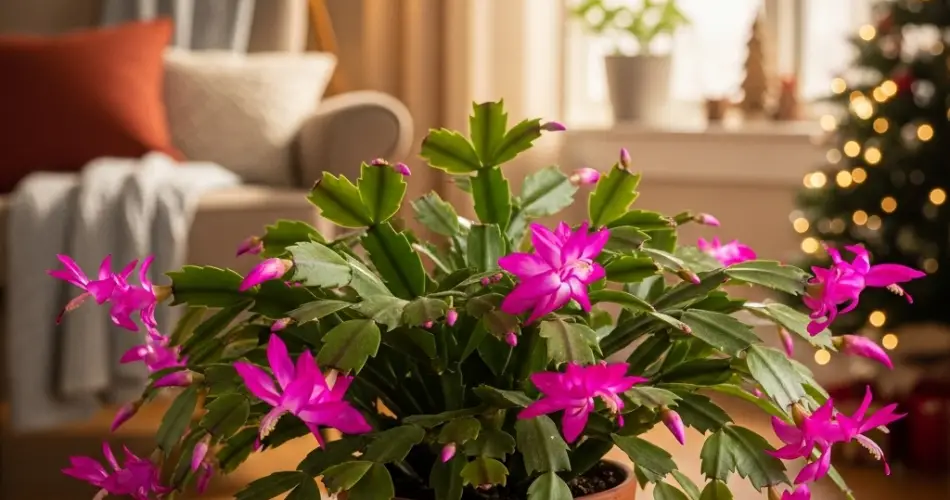The Christmas cactus (Schlumbergera spp.) is a beloved houseplant known for its bright, tubular flowers that bloom during the holiday season. Unlike its desert cousins, the Christmas cactus hails from tropical rainforests, making its care requirements a little different from what many assume. With the right indoor conditions, this festive plant can thrive and bloom beautifully year after year.
Here’s a complete guide to creating the best environment for a happy and healthy Christmas cactus indoors.
1. Light: Bright but Indirect
While the Christmas cactus appreciates plenty of light, it does not enjoy direct sunlight. In its natural habitat, it grows under the canopy of trees, receiving filtered light.
-
Best Placement: A spot near an east-facing window is ideal. If using a south or west-facing window, make sure to filter the light with a sheer curtain.
-
Avoid Direct Sun: Too much sun can cause the leaves to turn red or yellow, a sign of stress.
During winter, when days are shorter, providing a few extra hours of bright light helps encourage blooming.
2. Temperature: Cool and Consistent
Christmas cactus thrives in moderate indoor temperatures but prefers cooler nights to help trigger blooming.
-
Ideal Range: 65°F to 75°F (18°C to 24°C) during the day, with a drop to around 55°F to 60°F (13°C to 16°C) at night.
-
Avoid Extremes: Keep the plant away from drafts, heating vents, and cold windows. Sudden temperature shifts can stress the plant and delay or prevent flowering.
To encourage bud formation in the fall, try placing your cactus in a cooler room for a few weeks before the holiday season.
3. Humidity: Higher is Better
Unlike desert cacti, the Christmas cactus comes from humid environments and benefits from moist air.
-
Humidity Level: Aim for 40–60% humidity indoors.
-
How to Increase Humidity:
-
Use a humidifier in the room.
-
Place the pot on a tray of pebbles and water, ensuring the pot doesn’t sit directly in the water.
-
Group with other plants to create a microclimate.
-
Dry indoor air, especially in winter, can cause the leaves to shrivel or buds to drop before blooming.
4. Watering: Keep It Moist, Not Wet
Christmas cactus prefers evenly moist soil during active growth and blooming periods. However, overwatering can quickly lead to root rot.
-
Water When Top Inch Is Dry: Check the soil by inserting your finger into the top inch. If it’s dry, it’s time to water.
-
Reduce Watering After Blooming: Once the flowers have faded, reduce watering frequency and allow the soil to dry more between waterings.
-
Water Thoroughly: Water until it drains from the bottom of the pot, and always empty the saucer to prevent standing water.
During active bloom, regular watering helps the flowers last longer, but the plant should never sit in soggy soil.
5. Soil and Pot: Drainage Is Key
Good drainage is essential to prevent overwatering issues.
-
Best Soil: Use a lightweight, well-draining potting mix. A cactus or succulent blend works well, or mix regular potting soil with perlite or coarse sand.
-
Container: Choose a pot with drainage holes. Terracotta pots are a good option as they allow excess moisture to evaporate more easily.
Repot your Christmas cactus every 2–3 years in spring, refreshing the soil to maintain good drainage and root health.
6. Feeding: Light But Regular
While not heavy feeders, Christmas cacti benefit from regular fertilization during their growing season.
-
When to Fertilize: Feed monthly from spring through early fall using a balanced, water-soluble fertilizer diluted to half strength.
-
Pause Feeding in Fall: Stop fertilizing in mid to late fall when the plant prepares for blooming. Resume feeding after flowering ends and new growth begins.
Avoid over-fertilizing, which can result in excess foliage at the expense of flowers.
7. Encouraging Blooms
To trigger flowering, the Christmas cactus needs a combination of cool temperatures and darkness at night.
-
Dark Periods: In the fall, give the plant 12–14 hours of darkness per day for about 6 weeks.
-
Cooler Nights: Maintain nighttime temperatures around 55°F to 60°F (13°C to 16°C) to stimulate bud development.
-
Avoid Moving: Once buds form, avoid relocating the plant, as even small changes in light or temperature can cause bud drop.
Once blooming begins, return the plant to its normal light and warmth to enjoy a long-lasting floral display.
8. General Maintenance Tips
-
Rotate the Plant: Turn the pot occasionally for even growth.
-
Remove Dead Blooms: Snip off faded flowers to encourage continued blooming and prevent disease.
-
Check for Pests: Look out for mealybugs, spider mites, or fungus gnats. Treat promptly with insecticidal soap or neem oil if needed.
Final Thoughts
A thriving Christmas cactus isn’t hard to achieve when you mimic its native conditions: bright indirect light, moderate temperatures, steady moisture, and a touch of humidity. With proper care and a bit of attention during the bloom-triggering months, this cheerful plant will reward you with vibrant blooms that brighten your home just in time for the holidays—year after year.



